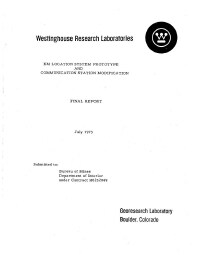Mining Publication: EM Location System Prototype and Communication Station Modification
Original creation date: July 1973
Authors: AJ Farstad, C Fisher, RF Linfield
NIOSHTIC2 Number: 10001481
Westinghouse Research Laboratories. U.S. Bureau of Mines contract No. H0232049. NTIS: PB-226660, 1973 Jul; :107 pages
A prototype electromagnetic (em) location system consisting of six miniature transmitters, six miniature receivers, and one multichannel receiver was developed by Westinghouse Georesearch Laboratory and is described in this report. The equipment was designed to operate in a deep coal mine of relatively high overburden conductivity. One mine having these characteristics is the Geneva Coal Mine operated by the U.S. Steel Corp. near Dragerton, Utah. The equipment was tested there. The system consisted of six manpack transmitters and six manpack receivers covering the frequency band from 900 hz to 2,900 hz as well as a six- channel receiver designed for use in a helicopter. Tests showed that em signals from lightweight (3/4 lb) transmitters could be detected both on the surface and from a helicopter through as much as 1,650 feet of relatively high conductivity (2 x 102 mhos/m) overburden. Furthermore, the resulting field strength profiles could be used to determine source location to within 150 feet of the actual surveyed location in the mine.

NIOSHTIC2 Number: 10001481
Westinghouse Research Laboratories. U.S. Bureau of Mines contract No. H0232049. NTIS: PB-226660, 1973 Jul; :107 pages
- Evaluation of the Black River Mine Telecommunication System
- Mine Communications: An Overview of the Bureau of Mines Communications Research
- Remote Gob Gas Venthole Monitoring and Cellular Telephone-Based Real-Time Data Transmission System
- Research and Development Contract for Coal Mine Communication System: Volume 1 - Summary and Results of System Study
- Research and Development Contract for Coal Mine Communication System: Volume 2 - Mine Visits
- Surface Magnetic Field Noise Measurements at Geneva Mine
- Survey of Electromagnetic and Seismic Noise Related to Mine Rescue Communications: Volume I - Emergency and Operational Mine Communications
- Survey of Electromagnetic and Seismic Noise Related To Mine Rescue Communications: Volume II - Seismic Detection and Location of Isolated Miners
- Three Dimensional Microseismic Monitoring of a Utah Longwall
- Underground Mine Communications, Control and Monitoring